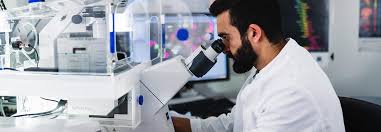Principles of Applied Microbiology
Microbiology is the study of small (microscopic) organisms which are too small to be viewed with unaided eyes and could be plants, animals or inanimate objects.
It is through such studies that microscopic bacteria, protozoa, viruses, fungi etc. were discovered and their behavioral characteristics known.
In the field of microbiology, many branches of it exist, thus we have things like: environmental microbiology, microbiological ecology, applied microbiology and microbial biotechnology. All these relate and differ slightly at different times and occasions.
Whereas microbial ecology is the study of the interaction of micro-organisms within the environment, environmental microbiology is an applied field where the study of micro-organisms in the environment leading to the benefit of the society is emphasized.
It is a subset of applied microbiology and interfaces with water, waste-water, air, soil, food, industrial microbiology and others.
Microbial biotechnology encompasses the field which includes the manipulation of the microbes to increase their practical benefit wherein the principles of applied microbiology are applied.
Read Also: Characteristics and Flow Rates of Waste-Water
Applied microbiology is a multidisciplinary scientific discipline that leverages the principles of microbiology to address practical challenges and provide tangible solutions across various industries and sectors. As an expert in the field, let me break down the meaning of applied microbiology.
Applied microbiology is the practical application of microbial knowledge to meet societal needs and overcome challenges in diverse fields. It embodies a proactive and solution-oriented approach, showcasing the versatility of microorganisms in addressing issues and advancing human well-being.
Microbiology, at its core, is the study of microorganisms; tiny, often microscopic life forms such as bacteria, viruses, fungi, and protozoa.
Applied microbiology takes this knowledge and applies it to real-world problems and applications. It serves as the bridge between fundamental microbial understanding and its practical utilization for the benefit of society.
Here are key aspects of applied microbiology:
1. Industrial Processes: Applied microbiology plays a crucial role in various industrial processes. For example, in the food industry, microorganisms are harnessed for fermentation, preserving food, and producing various products such as cheese, yogurt, and beverages.
2. Biotechnology: The field of biotechnology heavily relies on applied microbiology. Microorganisms are manipulated and engineered to produce valuable substances, such as enzymes, biofuels, pharmaceuticals, and recombinant proteins.
3. Environmental Applications: Microorganisms are employed for environmental remediation, waste treatment, and pollution control. Applied microbiologists develop strategies to use microbes to break down pollutants, clean up oil spills, and enhance soil fertility.
4. Medical Microbiology: In medicine, applied microbiology is evident in diagnostics, vaccine development, and the study of microbial pathogenesis. It contributes to the prevention and treatment of infectious diseases.
5. Agricultural Microbiology: Applied microbiology is instrumental in agriculture, promoting soil health and plant growth. Microbes can be used as biofertilizers, biopesticides, and for enhancing nutrient availability in the soil.
6. Pharmaceuticals: Microorganisms are a source of many antibiotics and therapeutic agents. Applied microbiology is involved in the discovery, development, and production of pharmaceutical compounds derived from microbial sources.
7. Research and Development: Applied microbiologists engage in research and development activities to explore new ways in which microorganisms can be harnessed for innovative solutions. This may involve genetic engineering, optimization of fermentation processes, and exploring novel microbial strains.
8. Quality Control and Assurance: In various industries, including food and pharmaceuticals, applied microbiologists are essential for ensuring product quality and safety. They develop and implement strategies to detect and control microbial contaminants.
Read Also: Estimating Waste-water Flow Rates from Water Supply Data
Waste-water Microbiology
The new focus of environment as a whole has led to the development of new activities related to the application of principles of water, waste- water and air microbiology which forms the scope of environmental biotechnology.
This part addresses various aspects of waste-water treatment since generally it is now suitably treated before dumping into the rivers/streams so as to reduce the threat of waterborne diseases.
Self-Purification
The fate of the discharged waste is determined by the self-purification potential of the receiving water body.
Self-purification is based on biogeochemical cycling activities and inter-population relationships of the indigenous (autochthonous) microbial populations. Organic nutrients are mineralized by the heterotrophic aquatic organisms.
Ammonia is nitrified and inorganic nutrients are utilized by higher aquatic plants. Non-indigenous (alochthonous) population of enteric pathogens that enter through waste is eliminated by competition and predation of the autochthonous microorganisms.
The waste-water may overwhelm the self-purification capacity of the aquatic system causing pollution of receiving water. Depending on the climatic and environmental factors the water may attain an acceptable quality level in the stream, downstream from the sewage outfall.
A well-defined profile of pollution and self- purification of the receiving water is obtained by a succession of changes in water quality that occurs on the downstream of the point source of pollution as seen in the figure below.
Self-purification is a slow process and a heavily polluted stream may have to traverse quite a long distance for days to get purified. Whenever the waste-water is discharged, the suspended matter either settles at the bed near the point of discharge or gets carried away.

The organic matter is utilized by the aerobic micro-organisms reducing the dissolved oxygen. As the organic matter is depleted, the number of micro-organisms is also reduced. The re-aeration rate of the atmosphere catches up.
The water becomes clear and the stream returns to the original condition and the self-purification is accomplished. The Biochemical Oxygen Demand (BOD) and the Dissolved Oxygen (DO) of the receiving waters are parameters that give good measure of pollution that exists in the receiving stream.
Read Also: Cow’s Milk: Economic Benefits and Uses



